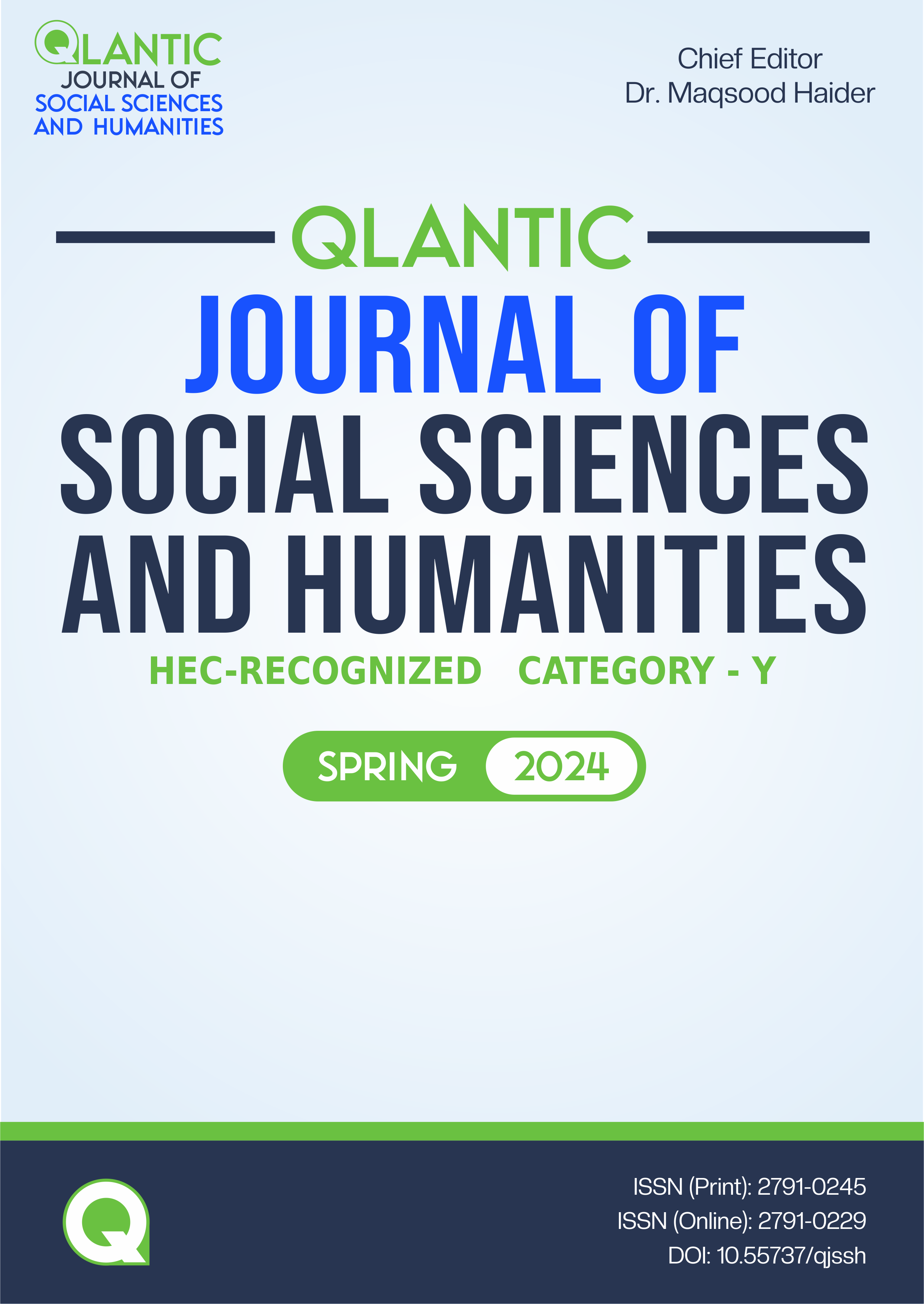Occupational and Environmental Health Hazards among Agriculture Laborers: An Evidence-Based Study from Punjab, Pakistan
DOI:
https://doi.org/10.55737/qjssh.319469392Keywords:
Agricultural Laborer, Socio-economic Problems, Agricultural Development, Agricultural Labor ForceAbstract
Laborers from the agriculture sector have often been victims rather than beneficiaries of the green revolution, technological development, and globalization trends that characterized the 20th century. In recent decades, the laborers working in the agriculture sector have been half of the world’s labor force, with an estimated number of 1.3 billion worldwide, and a majority of them found in developing countries. Adequate balance between agricultural growth and protection from occupational & environmental health hazards is very crucial for the future of the world’s food production and for the sustainability of the sector. The study was conducted in three divisions of Punjab, and primary data was collected through multistage simple random sampling techniques. The interview schedule was used as a tool for data collection. The results revealed that the occupational and environmental circumstances of the laborers were not conducive towards their health and well-being. The agricultural laborers have to face many health hazards, whereas the majority of the laborers were exploited only due to their illiteracy and ignorance about Government policies and laws related to them. A huge proportion of the participants reported chronic health, malnutrition, and socio-economic problems significantly associated with their working environment, amenities and available facilities.
References
Ahmad, M., Kumari, M., Kumar, N., Goswami, G., Fahad, S., & Asgher, Md. S. (2023). Assessing livelihood vulnerability to climate variability in the Himalayan region: a district-level analysis of Jammu Province, India. GeoJournal. https://doi.org/10.1007/s10708-023-10829-2
Bezner Kerr, R., Madsen, S., Stüber, M., Liebert, J., Enloe, S., Borghino, N., Parros, P., Mutyambai, D. M., Prudhon, M., & Wezel, A. (2021). Can agroecology improve food security and nutrition? A review. Global Food Security, 29, 100540. https://doi.org/10.1016/j.gfs.2021.100540
Chothodi, S., Patidar, H., Parmar, K., & Mishra, R. (2022) Environment and human well-being: revisiting linkages and major issues. The Indian Geographical Journal, 97(1), 1–16. https://mail.igschennai.org/IGJ/2022/Jun/IGJ_Vol97_1_June2022_1.pdf
D’Annolfo, R., Gemmill-Herren, B., Amudavi, D., Shiraku, H. W., Piva, M., & Garibaldi, L. A. (2020). The effects of agroecological farming systems on smallholder livelihoods: a case study on push–pull system from Western Kenya. International Journal of Agricultural Sustainability, 1–15. https://doi.org/10.1080/14735903.2020.1822639
Ewert, F., Baatz, R., & Finger, R. (2023). Agroecology for a Sustainable Agriculture and Food System: From Local Solutions to Large-Scale Adoption. Annual Review of Resource Economics, 15(1), 351–381. https://doi.org/10.1146/annurev-resource-102422-090105
Falconnier, G. N., Cardinael, R., Corbeels, M., Baudron, F., Chivenge, P., Couëdel, A., Ripoche, A., Affholder, F., Naudin, K., Benaillon, E., Rusinamhodzi, L., Leroux, L., Vanlauwe, B., & Giller, K. E. (2023). The input reduction principle of agroecology is wrong when it comes to mineral fertilizer use in sub-Saharan Africa. Outlook on Agriculture, 52(3), 311–326. https://doi.org/10.1177/00307270231199795
Feng, Y., Chen, H., & Zheng, X. (2022). Component analysis of ancient glass products based on hierarchical analysis clustering algorithm. Highlights in Science, Engineering and Technology, 21, 180–185. https://doi.org/10.54097/hset.v21i.3155
George, A., Sharma, P., & Pradhan, K. C. (2023). Spatiotemporal Pattern of Vulnerability to Climate Change in Madhya Pradesh, India. Applied Spatial Analysis and Policy, 17(1), 55–85. https://doi.org/10.1007/s12061-023-09535-w
Kumar, A., Kumar, S., Kuldeep Singh Rautela, Kumari, A., Sulochana Shekhar, & Mohanasundari Thangavel. (2023). Exploring temperature dynamics in Madhya Pradesh: a spatial-temporal analysis. Environmental Monitoring and Assessment, 195(11). https://doi.org/10.1007/s10661-023-11884-5
Milheiras, S. G., Sallu, S. M., Loveridge, R., Nnyiti, P., Mwanga, L. E., Baraka, E., Lala, M., Moore, E., Shirima, D. D., Kioko, E. N., Marshall, A., & Pfeifer, M. (2022). Agroecological practices increase farmers’ well-being in an agricultural growth corridor in Tanzania. Agronomy for Sustainable Development, 42(4). https://doi.org/10.1007/s13593-022-00789-1
Paracchini, M. L., Justes, E., Wezel, A., Zingari, P. C., Kahane, R., Masden, S., Scopel, E., Héraut, A., Bhérer-Breton, P., Buckley, R., Colbert, E., Kapalla, D., Sorge, M., Adu Asieduwaa, Kerr, R. B., Maes, O., & Nègre, T. (2020, September 17). Agroecological practices supporting food production and reducing food insecurity in developing countries. Isara.hal.science. https://isara.hal.science/hal-03653197
Patri, P., Sharma, P., & Patra, S. K. (2022). Does economic development reduce disaster damage risk from floods in India? Empirical evidence using the ZINB model. International Journal of Disaster Risk Reduction, 79, 103163. https://doi.org/10.1016/j.ijdrr.2022.103163
Peeters A, Škorjanc K, Wezel A, Migliorini P (2021) OASIS, the Original Agroecological Survey Indicator System. A simple and comprehensive system for agroecological transition assessment. Agroecology Europe, Corbais, Belgium.
Pradhan, K. C., & Narayanan, K. (2020). Does climatic risk induce labour migration? Evidence from Semi‐Arid Tropics region of India. Journal of Public Affairs, 22(1). https://doi.org/10.1002/pa.2323
Rautela, K. S., Kuniyal, J. C., Alam, M. A., Bhoj, A. S., & Kanwar, N. (2022). Assessment of Daily Streamflow, Sediment Fluxes, and Erosion Rate of a Pro-glacial Stream Basin, Central Himalaya, Uttarakhand. Water, Air, & Soil Pollution, 233(4). https://doi.org/10.1007/s11270-022-05567-z
Rehman, S., Azhoni, A., & Chabbi, P. H. (2022). Livelihood vulnerability assessment and climate change perception analysis in Arunachal Pradesh, India. GeoJournal. https://doi.org/10.1007/s10708-022-10703-7
Saikh, N. I., & Mondal, P. (2023). GIS-based machine learning algorithm for flood susceptibility analysis in the Pagla river basin, Eastern India. Natural Hazards Research, 3(3), 420–436. https://doi.org/10.1016/j.nhres.2023.05.004
Sengupta, A., & Mohanasundari Thangavel. (2023). Analysis of the Effects of Climate Change on Cotton Production in Maharashtra State of India Using Statistical Model and GIS Mapping. Caraka Tani, 38(1), 152–152. https://doi.org/10.20961/carakatani.v38i1.64377
Sharma, A. (2023). Drought risk management in Madhya Pradesh, India: a policy perspective. International Journal of Emergency Management, 18(1), 23–23. https://doi.org/10.1504/ijem.2023.129408
Venus, T. E., Bilgram, S., Sauer, J., & Khatri-Chettri, A. (2021). Livelihood vulnerability and climate change: a comparative analysis of smallholders in the Indo-Gangetic plains. Environment, Development and Sustainability, 24(2), 1981–2009. https://doi.org/10.1007/s10668-021-01516-8
Published
Issue
Section
License
Copyright (c) 2024 Qlantic Journal of Social Sciences and Humanities

This work is licensed under a Creative Commons Attribution-NonCommercial 4.0 International License.





